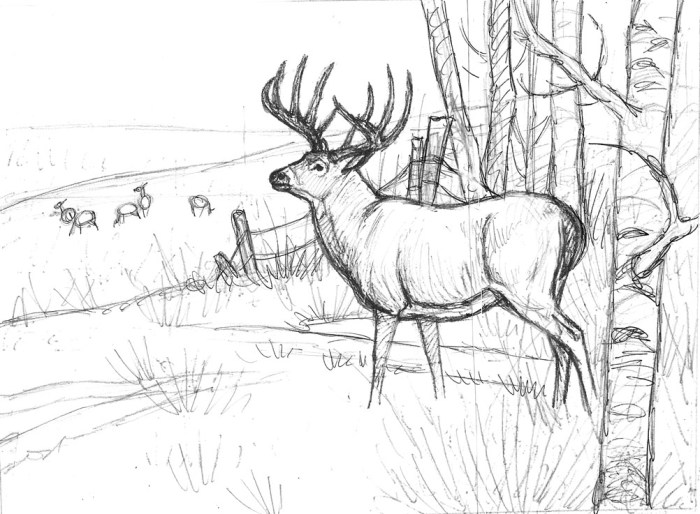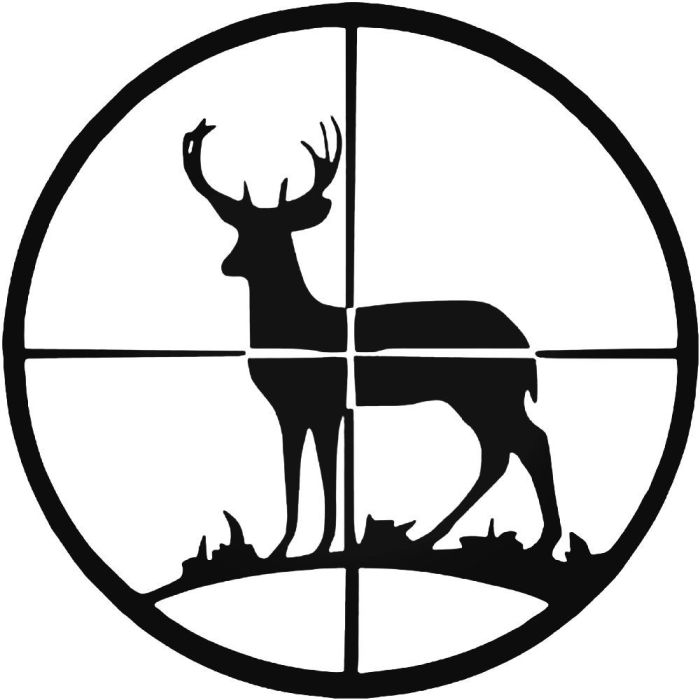Doodle Easy Drawing of Hunting
Defining “Easy Drawing of Hunting”
Doodle easy drawing of hunting – Embarking on the journey of artistic expression doesn’t require complex techniques. A simple hunting-themed drawing can be incredibly fulfilling, especially for beginners. The key lies in capturing the essence of the hunt with minimal detail, focusing on clear lines and easily recognizable forms. This approach allows for quick sketching and experimentation, fostering confidence and enjoyment in the creative process.An easy drawing of hunting prioritizes simplicity and clarity.
It’s about conveying the core idea of the hunt without getting bogged down in intricate details. Think bold Artikels, basic shapes, and a focus on the key elements that define the scene. This isn’t about photorealism; it’s about capturing the spirit and action of the hunt in a readily understandable manner.
Characteristics of Simple Hunting Drawings
A simple hunting drawing for beginners should feature easily replicated shapes and lines. Avoid overly complex perspectives or detailed textures. Instead, opt for straightforward representations of the hunter, the prey, and the environment. Consider using solid colors or simple shading to add depth, but don’t get caught up in nuanced color gradients or complex lighting effects. The goal is to create a clear and understandable image, not a masterpiece of realism.
For example, a hunter could be represented by a simple stick figure with a slightly curved line to represent a bow or a simple rectangle to represent a rifle. The prey could be a simple Artikel of an animal, perhaps a deer or a bird, with only a few key features indicated.
Examples of Easily Represented Hunting Scenes, Doodle easy drawing of hunting
Several common hunting scenes lend themselves well to simple doodles. A hunter aiming a bow and arrow at a deer in a forest clearing is easily represented with basic shapes and lines. The hunter could be a simple stick figure, the deer a few simple curves and circles, and the forest a collection of vertical lines. Another example is a hunter with a rifle aiming at a bird in flight.
The bird can be a simple shape, such as an elongated oval with wings represented by a couple of slightly curved lines. A hunter tracking an animal through a snowy landscape can be depicted with simple footprints in the snow and a silhouette of a hunter. The emphasis remains on the core elements, conveying the essence of the action without unnecessary complexity.
Essential Elements for Conveying the Concept of Hunting
To successfully portray hunting in a simple drawing, certain essential elements should be included. The hunter is obviously paramount, even if represented simply. Then, the prey needs to be present, whether it’s a deer, a bird, or another animal. A simple representation suffices; detailed anatomy isn’t necessary. Finally, the environment plays a significant role in setting the scene.
A few simple lines to indicate trees, a field, or a mountain range can add context and enhance the overall composition. These three core elements – hunter, prey, and environment – are sufficient to convey the idea of hunting in an easy and accessible drawing. Even minimal details, such as a simple arrow or gun, can significantly enhance the narrative.
Doodle Styles for Hunting Scenes

Unlocking the potential of doodle art in depicting hunting scenes requires exploring diverse stylistic approaches. The choice of style significantly impacts the overall feel and message conveyed, ranging from minimalist elegance to playful cartoonishness. Let’s delve into the nuances of different doodle styles and how they can be applied effectively.
Different doodle styles offer unique visual interpretations of hunting. Consider the desired mood and the level of detail required. A minimalist approach emphasizes simplicity and clean lines, while a cartoonish style prioritizes humor and exaggeration. A simplified realistic style aims for a degree of accuracy without the complexity of photorealism. The selection of style dictates the level of detail and the overall aesthetic.
Simple doodles of hunting scenes, perhaps a lone hunter with a bow, can be surprisingly effective. For a more dramatic contrast, consider adding a backdrop of a spooky, haunted setting; you might find inspiration from tutorials on drawing a large scary house drawing easy , incorporating elements like jagged windows and looming shadows. Then, return to your hunting scene, using the contrast to heighten the tension and atmosphere of your simple doodle.
Comparison of Minimalist, Cartoonish, and Simplified Realistic Doodle Styles
Minimalist doodles use basic shapes and lines to represent hunters and their prey. Think of a simple stick figure hunter with a similarly simplified deer. Cartoonish doodles exaggerate features for comedic effect; the hunter might have comically oversized boots and the deer comically large antlers. Simplified realistic doodles strive for anatomical accuracy, but with simplified details and fewer lines, maintaining a sense of naturalism within the confines of a quick sketch.
The contrast lies in the level of detail and the intended emotional response.
Line Weights and Shading Techniques in Simple Hunting Doodles
Line weight plays a crucial role in creating depth and emphasis. Thicker lines can define the Artikels of main subjects, while thinner lines add detail or create a sense of distance. Shading can be achieved through hatching (parallel lines), cross-hatching (intersecting lines), or stippling (dots). A simple example: a thicker line for the hunter’s rifle, thinner lines for the details of their clothing, and hatching to indicate shadows on the prey animal.
Experimentation with varying line weights and shading techniques can significantly enhance the visual impact of the doodle.
Three Distinct Doodle Styles Depicting a Hunter and Their Prey
Let’s visualize three distinct styles. First, a minimalist style: A simple stick figure hunter with a single, thin line for a bow and arrow, aiming at a similarly simplified geometric deer shape. Second, a cartoonish style: A hunter with oversized boots and a wide-brimmed hat, holding a comically large rifle, aiming at a deer with comically exaggerated antlers, running with its tongue hanging out.
Third, a simplified realistic style: A hunter with a clearly defined silhouette, wearing simple clothing, holding a rifle; the prey, a deer, is depicted with simplified anatomical features, showing its muscular structure but without intricate details, suggesting a sense of movement and alertness. These examples highlight the versatility of doodle styles in capturing diverse interpretations of a hunting scene.
Variations and Creative Expansions

Let’s elevate your hunting doodles from simple sketches to captivating miniature masterpieces! We’ll explore ways to inject personality and detail without losing the effortless charm of the doodle style. Remember, the goal is to enhance, not overcomplicate.Adding personality and environmental elements breathes life into your hunting scenes, transforming them from static images into dynamic narratives. Consider this as adding the spices to your culinary creation; a pinch here, a dash there, makes all the difference.
Adding Personality and Detail to Hunting Doodles
Enhancing a basic hunting doodle involves subtle additions that speak volumes. Instead of a generic hunter, give them a unique hat, a specific pose, or even a quirky expression. A simple change in the angle of a rifle or the positioning of a hunting dog can instantly increase the dynamism of the scene. Similarly, adding texture to the fur of the hunted animal or the clothing of the hunter, through simple hatching or cross-hatching, can create a sense of depth and realism.
For example, instead of a plain arrow, you could add fletching details or show it piercing its target. The key is to use these details sparingly; less is often more in the doodle style.
Incorporating Backgrounds and Environmental Elements
Don’t limit your hunting doodle to just the hunter and the prey. Consider the environment! A simple line or two can suggest a forest, mountains, or a field. Adding a few carefully placed trees, rocks, or even a distant sun can dramatically increase the context and interest of your drawing. For instance, a few jagged lines could represent a rocky mountain range, while a series of slightly curved lines could depict a flowing river.
Remember to keep these background elements simple and suggestive, avoiding excessive detail that could clutter the overall composition.
Three Variations of a Single Hunting Doodle
Let’s imagine a basic doodle: a hunter with a bow and arrow aiming at a deer.
Variation 1: Minimalist
This version maintains the core elements – the hunter, the bow, the arrow, and the deer – but keeps the details minimal. The hunter is represented by a simple stick figure, the bow and arrow are basic shapes, and the deer is a simplified Artikel. The background is absent, focusing all attention on the central action. The lines are thin and consistent, maintaining the lightheartedness of a doodle.
Variation 2: Moderate Detail
Here, we add some personality and environmental context. The hunter now has a slightly more defined body, perhaps wearing a simple hat. The deer is more detailed, with discernible legs and antlers. A few simple trees are added in the background to suggest a forest setting. The lines remain relatively simple, but some variations in thickness and shading are introduced to add subtle depth and emphasis.
Variation 3: Detailed Doodle
This version incorporates more complex details and a richer background. The hunter has a more realistic pose, perhaps with a determined expression. The deer has more defined musculature and fur texture is suggested through hatching. The background features more detailed trees, undergrowth, and perhaps even a glimpse of a distant mountain. The lines vary considerably in thickness and density to create a sense of depth and movement.
However, even with this level of detail, the overall style remains loose and expressive, retaining the essence of a doodle.
FAQ Corner: Doodle Easy Drawing Of Hunting
What materials do I need to start doodling hunting scenes?
Just a pencil, paper, and an eraser will do! Colored pencils, markers, or even digital drawing tools can add extra flair.
Can I use these doodles for social media?
Absolutely! Share your awesome creations on Instagram, TikTok, or wherever you hang out online. #HuntingDoodles for extra cool points!
What if my doodles don’t look perfect?
Doodling is all about fun and expression! Don’t sweat the small stuff. Embrace imperfections – they add character!
Are there any online resources for more hunting doodle inspiration?
Totally! Search Pinterest or Instagram for “hunting doodles” or “wildlife doodles” to find tons of awesome ideas and inspiration!



